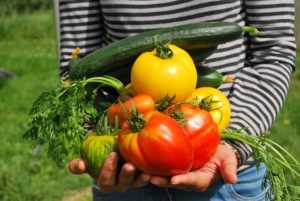 We all know that fruits and vegetables are important. And most of us don’t eat enough. How many cups or servings of vegetables do you need per day? It depends. This web-based tool from the United States Department of Agriculture (USDA) can help you.
We all know that fruits and vegetables are important. And most of us don’t eat enough. How many cups or servings of vegetables do you need per day? It depends. This web-based tool from the United States Department of Agriculture (USDA) can help you.
Vital to Health
Vegetables and fruits contain vitamins and minerals vital to health. Eating more vegetables and fruits may protect against certain types of cancers and reduce risk against chronic diseases such as heart disease and diabetes and help with weight maintenance.
Saving Money
Unfortunately, the price of fruits and vegetables can get expensive, especially when they are not in season. Here are some tips to consider on how to save on your fruit and vegetable grocery expense.
- Take advantage of seasonal fruits and vegetables by buying in bulk and then, properly freeze them to ensure quality and nutrition. Colorado State University’s (CSU) website has all the information on how to freeze every vegetable and fruit. The same website has the information on how to can or dry them as well.
- Check your local grocery website or newspaper for weekly deals on fruits and vegetables. Not only are produce that’s in season generally cheaper, but they’re also at the peak of flavor.
- Buying frozen vegetables and fruits can save money because they don’t have the risk of going bad on the kitchen counter.
- You can also grow your own vegetables and fruits. The CSU Extension Master Gardener website has all the information specific to the climate and environmental conditions of Colorado that you’ll need to start a garden. Just remember to properly freeze, can or dry your extra produce.
Cooking for 1 or 2
Another challenge to eating more fruits and vegetables is when you are preparing food for only one or two people. This is where meal planning can help. Keep a variety of fruits and vegetables that you can pull easily from your freezer or pantry. For more tips on cooking for one or two, check out this fact sheet from CSU Extension and this article from the Mayo Clinic.
 Tips for Getting Family to Eat More Fruits and Vegetables
Tips for Getting Family to Eat More Fruits and Vegetables
Once you have all the produce in your kitchen, the next challenge is how to incorporate them in your everyday meals and how to get your family to eat them. Here are some tips.
- Wash, peel, and slice what your family can eat for a few days when you get home from the store or as soon as you can. Place them in a clear container in the refrigerator where everyone can see them and grab them easily.
- Aside from salads, stir-fries and soups are a great way to increase eating vegetables. Try this Bean and Macaroni Soup or a classic Italian soup like Minestrone. You can also add fresh or frozen chopped vegetables to your favorite soup recipes. Colorado peach season is nearly here, try this Vegetable and Peach Stir-fry recipe from Cornell University Cooperative Extension.
- Use a lettuce leaf as a substitute for tortilla in fajita, for the egg roll wrapper in egg rolls, and for the rice wrapper in Vietnamese spring rolls. Just fully cook all the filling ingredients and serve it with washed whole lettuce leaves on the table.
- Encourage your kids to help with food preparation and cooking. Kids tend to appreciate foods when they see how it was prepared. Depending on the ages of the children, some can help with removing stems of snow peas and green beans, while older children can help with the chopping and slicing.
- Use eggplant or zucchini instead of lasagne noodles in lasagna.
- Add vegetables to egg dishes, such as omelet, frittata, and vegetable egg casserole.
- Use riced cauliflower or riced broccoli for your fried “rice”. Here’s a recipe from the University of Maryland Extension.

Have Fun
Have fun trying new fruits and vegetables and recipes! Remember to rotate through the different types of produce, such as, green leafy vegetables, yellow and orange vegetables, berries, citrus fruits, red fruits and vegetables, and beans and peas.

